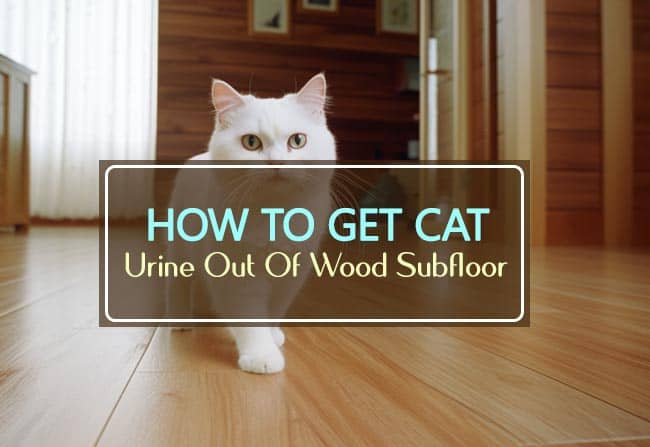Dealing with cat urine on a wood subfloor can be a challenging task, but with the right techniques, it can be resolved effectively. Cat urine can cause unpleasant odors and can even seep into the subfloor, leading to long-term damage. To get rid of cat urine from a wood subfloor, there are several steps you can take.
First, start by identifying the affected areas using a blacklight or your sense of smell. Then, thoroughly clean the surface with an enzymatic cleaner specifically designed to break down the uric acid present in cat urine. Allow the cleaner to sit for a recommended duration before wiping it away.

To eliminate any lingering odors, consider using an odor neutralizer or baking soda. Finally, ensure proper ventilation in the area to aid in drying and prevent the growth of mold. Taking these steps will help you effectively remove cat urine from your wood subfloor and restore its freshness.

DIY Solutions: Simple Steps to Eliminate Cat Urine Odor from Wood Subfloors
If you have a cat, you know how wonderful they can be as pets. They provide companionship, entertainment, and a lot of love. However, one issue that cat owners often face is dealing with the unpleasant odor of cat urine. This can be especially problematic if your cat has had an accident on your wood subfloors. The strong smell can linger and be difficult to eliminate. Luckily, there are DIY solutions that can help you tackle this problem and get rid of the cat urine odor once and for all.
Step 1: Identify the Affected Areas
The first step in eliminating cat urine odor from wood subfloors is to identify the affected areas. This can be done by using a blacklight, which will make any urine stains glow. Carefully inspect the subfloors and mark any areas that are affected.
Step 2: Remove any Surface Stains
Before you can effectively eliminate the odor, you must first remove any surface stains. Start by cleaning the affected areas with a mixture of water and mild soap. Scrub gently to lift any stains. Rinse the area thoroughly and allow it to dry completely.
Step 3: Neutralize the Odor
Once the surface stains have been removed, it’s time to neutralize the odor. There are several DIY solutions that can help with this. One effective option is a mixture of white vinegar and water. Mix equal parts vinegar and water in a spray bottle and generously spray the affected areas. Vinegar is known for its natural odor-fighting properties and can help eliminate the cat urine smell. Allow the vinegar solution to sit for about 10-15 minutes, then wipe it away with a clean cloth.
Another option is to use hydrogen peroxide. Mix one part hydrogen peroxide with two parts water and apply it to the affected areas. Hydrogen peroxide is a powerful disinfectant and can help eliminate the odor-causing bacteria. Allow the solution to sit for a few minutes, then wipe it away with a clean cloth.
Step 4: Seal the Subfloor
After neutralizing the odor, it’s important to seal the subfloor to prevent any lingering smells from coming back. You can use a specialized primer that is designed to block odors. Apply the primer according to the manufacturer’s instructions and allow it to dry completely. Once the primer is dry, you can proceed with installing new flooring or adding a layer of subfloor.
Step 5: Prevent Future Accidents
To prevent future accidents and cat urine odor on your wood subfloors, it’s important to address any underlying issues that may be causing your cat to urinate outside the litter box. Make sure the litter box is clean and easily accessible for your cat. Provide multiple litter boxes if you have multiple cats. If necessary, consult with a veterinarian to rule out any medical conditions that may be contributing to the problem.
In summary, eliminating cat urine odor from wood subfloors is a multi-step process that involves identifying the affected areas, removing surface stains, neutralizing the odor, sealing the subfloor, and preventing future accidents. By following these steps and using DIY solutions such as vinegar and hydrogen peroxide, you can effectively eliminate cat urine odor and restore the freshness to your wood subfloors.

Professional Cleaning Services: Restoring Wood Subfloors from Cat Urine Damage
Cat urine can be a stubborn and unpleasant problem to deal with, especially when it comes to wooden subfloors. The strong ammonia odor and the potential damage it can cause to the wood can be quite distressing for homeowners. In such situations, professional cleaning services come to the rescue, offering specialized solutions to restore wood subfloors from cat urine damage.
Professional cleaning services have the expertise and tools needed to tackle cat urine damage effectively. They follow a systematic approach to ensure the best possible results. Here is an overview of the process:
Evaluation and Inspection
The first step is to evaluate the extent of the damage and inspect the affected area. A trained professional will assess the condition of the wood subfloor, checking for any signs of staining, discoloration, or odor. This evaluation helps determine the appropriate course of action and develop a customized plan for cleaning and restoration.
Surface Cleaning
Before diving into extensive restoration procedures, the surface needs to be thoroughly cleaned. The professional cleaning team will remove any loose debris or dirt from the subfloor. This initial cleaning helps prepare the wood for deeper restoration treatments.
Deep Cleaning and Deodorizing
The next step involves deep cleaning the affected area to remove the cat urine and its odor. Professional cleaning services use specialized cleaning solutions that are safe for wood and effective in eliminating urine stains and smells. These solutions penetrate deep into the wood, breaking down the urine molecules and neutralizing the odor.
Depending on the severity of the damage, various techniques may be employed, such as steam cleaning, enzymatic cleaners, or ozone treatment. The choice of method depends on factors like the type of wood, the depth of the damage, and the extent of the odor.
Drying and Moisture Control
After the cleaning process, it is crucial to ensure proper drying and moisture control. Excess moisture can lead to warping, buckling, or mold growth in the wood. Professional cleaning services employ techniques like air movers, dehumidifiers, and moisture meters to thoroughly dry the subfloor and maintain optimal moisture levels.
Sealing and Refinishing
Once the subfloor is clean and dry, it may require sealing and refinishing to restore its original appearance and protect it from future damage. A professional cleaning team can help choose the appropriate sealant or finish that suits the type of wood and provides long-lasting protection against stains and odors.
Preventive Measures
Lastly, professional cleaning services may provide recommendations for preventive measures to avoid cat urine damage in the future. This could include suggestions for litter box placement, training techniques, or the use of protective mats or coatings on the subfloor.
Summary
Professional cleaning services play a vital role in restoring wood subfloors from cat urine damage. Their expertise, specialized tools, and systematic approach ensure effective cleaning, deodorizing, and restoration of the affected area. By employing their services, homeowners can successfully eliminate urine stains and odors, preserve the integrity of their wooden subfloors, and create a cleaner and healthier living environment for themselves and their feline companions.

Preventing Future Incidents: Tips for Keeping Cat Urine Off Your Wood Subfloor
If you are a cat owner, you are probably familiar with the challenges of dealing with cat urine. Not only does it create a strong odor, but it can also cause damage to your home, especially to your wood subfloor. Cat urine can seep through the flooring and leave behind stubborn stains and odors that are difficult to remove.
However, there are several steps you can take to prevent future incidents and keep your wood subfloor clean and odor-free. By following these tips, you can maintain a fresh and sanitary living environment for both you and your feline friend. Let’s take a look at some effective strategies:
1. Promptly Clean Up Accidents
The first and most important step in preventing cat urine from reaching your wood subfloor is to clean up any accidents as soon as they happen. The longer the urine sits on your flooring, the more it will seep into the wood and cause damage. Use an enzyme-based cleaner specifically designed for pet urine to thoroughly clean the affected area. These cleaners break down the urine molecules and eliminate the odor.
2. Use Cat Attractants
Consider using cat attractants, such as litter box attractant sprays or additives, to encourage your cat to use the litter box instead of urinating on your wood subfloor. These products contain pheromones or scents that cats find attractive, making them more likely to use the designated area. Spraying attractants on or near the litter box can help prevent accidents from occurring in the first place.
3. Provide Adequate Number of Litter Boxes
Make sure you have enough litter boxes in your home to accommodate all your cats. The general rule is to have one litter box per cat, plus an extra. Having multiple litter boxes reduces the likelihood of overcrowding and territorial disputes, which can lead to inappropriate urination. Place the litter boxes in easily accessible and quiet areas to encourage your cats to use them.
4. Keep Litter Boxes Clean
Cats are known for their cleanliness, and they prefer a clean litter box. Scoop the litter boxes daily and replace the litter regularly to keep them fresh and inviting. Dirty litter boxes can discourage your cat from using them, increasing the chances of accidents on your wood subfloor.
5. Provide Environmental Enrichment
Cats may urinate outside the litter box due to stress or boredom. Ensure your cat has plenty of mental and physical stimulation by providing toys, scratching posts, and interactive play sessions. This can help reduce anxiety and prevent your cat from seeking alternative spots to urinate.
6. Consider Waterproofing Options
If you have had repeated incidents of cat urine on your wood subfloor, you may want to consider applying a waterproof sealant to protect the wood. This can create a barrier that prevents urine from seeping into the flooring and causing damage. Consult with a professional for the best waterproofing options for your specific type of wood subfloor.
In summary, preventing future incidents of cat urine on your wood subfloor involves prompt cleanup, using cat attractants, providing an adequate number of litter boxes, keeping them clean, providing environmental enrichment, and considering waterproofing options. By implementing these strategies, you can maintain a clean and odor-free environment for both you and your furry companion.
5. Natural Remedies: Eco-Friendly Methods to Remove Cat Urine from Wood Subfloors
Cat urine stains and odors on wood subfloors can be a challenge to remove, but luckily, there are several eco-friendly methods that can effectively tackle this problem. These natural remedies not only help eliminate the strong smell of cat urine but also prevent any damage to the wood surface. In this section, we will explore some of the most effective eco-friendly solutions for removing cat urine from wood subfloors.
1. Vinegar and Water Solution
Vinegar is a versatile cleaning agent and can be highly effective in neutralizing cat urine odors. To prepare a vinegar and water solution, mix equal parts of white vinegar and water in a spray bottle. Thoroughly spray the affected area and allow it to sit for about 10-15 minutes. After that, use a clean cloth or mop to wipe away the solution. Repeat the process if necessary. Vinegar not only eliminates the odor but also helps to disinfect the area.
2. Baking Soda and Hydrogen Peroxide Paste
Baking soda is known for its odor-absorbing properties, while hydrogen peroxide is a natural disinfectant. When combined, these two ingredients can be highly effective in removing cat urine stains and odors from wood subfloors. To create a paste, mix equal parts of baking soda and hydrogen peroxide in a bowl. Apply the paste directly onto the stained area and gently scrub it using a soft brush. Allow the paste to sit for a few hours, then wipe it off with a clean cloth or mop. The baking soda and hydrogen peroxide paste will help lift the stain and eliminate the odor.
3. Enzyme-based Cleaners
Enzyme-based cleaners are specifically designed to break down organic materials, such as urine stains. These cleaners contain enzymes that effectively neutralize the odor and eliminate the stain. To use an enzyme-based cleaner, simply follow the instructions on the product label. Apply the cleaner to the affected area, ensuring that it penetrates the wood surface. Allow it to sit for the recommended amount of time, then wipe it away with a clean cloth or mop. Enzyme-based cleaners are a great eco-friendly option for removing cat urine from wood subfloors.
4. Tea Tree Oil and Water Solution
Tea tree oil is a natural antibacterial and antifungal agent that can effectively eliminate cat urine odors. To create a tea tree oil and water solution, mix a few drops of tea tree oil with water in a spray bottle. Shake the bottle well to ensure thorough mixing. Spray the solution onto the affected area and allow it to sit for about 10-15 minutes. After that, use a clean cloth or mop to wipe away the solution. Tea tree oil not only eliminates the odor but also helps to prevent the growth of bacteria and fungi.
5. Lemon Juice and Water Solution
Lemon juice is another natural ingredient that can help remove cat urine stains and odors from wood subfloors. Its acidic properties help break down the urine and neutralize the odor. To create a lemon juice and water solution, mix equal parts of lemon juice and water in a spray bottle. Thoroughly spray the affected area and allow it to sit for about 10-15 minutes. After that, use a clean cloth or mop to wipe away the solution. Lemon juice leaves a fresh citrus scent behind, masking any lingering odor.
These eco-friendly methods provide effective solutions for removing cat urine from wood subfloors. It’s important to act quickly when dealing with urine stains to prevent any long-term damage to the wood. By using these natural remedies, you can eliminate the odor and restore the beauty of your wood subfloors in an environmentally friendly way.
FAQs
1. How can I remove cat urine from a wood subfloor?
To remove cat urine from a wood subfloor, start by blotting the area with paper towels to remove excess liquid. Mix a solution of equal parts white vinegar and water, and use a cloth soaked in this solution to scrub the affected area. Rinse with clean water and dry thoroughly. Repeat the process if necessary, and consider using an enzyme cleaner specifically designed to eliminate pet urine odors.
2. What if the cat urine stain on the wood subfloor is old?
If the cat urine stain on the wood subfloor is old, you may need to take additional steps to remove it completely. Try using a specialized enzyme cleaner designed to break down and eliminate old pet urine stains. Follow the instructions on the cleaner, and allow sufficient time for it to work before rinsing and drying the area thoroughly.
3. Is it necessary to remove the subfloor to get rid of cat urine?
In most cases, it is not necessary to remove the entire subfloor to eliminate cat urine odor. With proper cleaning and treatment, including using enzyme cleaners, you should be able to effectively remove the odor from the wood subfloor. If the odor persists even after thorough cleaning, you may want to consult a professional for further assistance.
Conclusion
In conclusion, removing cat urine from a wood subfloor can be a challenging task, but it is not impossible. By using the right techniques and products, you can effectively eliminate the odor and stains caused by cat urine. Remember to start by identifying the affected areas and thoroughly cleaning them with an enzymatic cleaner. Allow sufficient time for the cleaner to break down the urine molecules. If necessary, you may need to repeat the process or consider refinishing the wood subfloor. Additionally, taking preventive measures like providing proper litter box training for your cat can help prevent future accidents. With patience and persistence, you can restore the cleanliness and freshness of your wood subfloor.